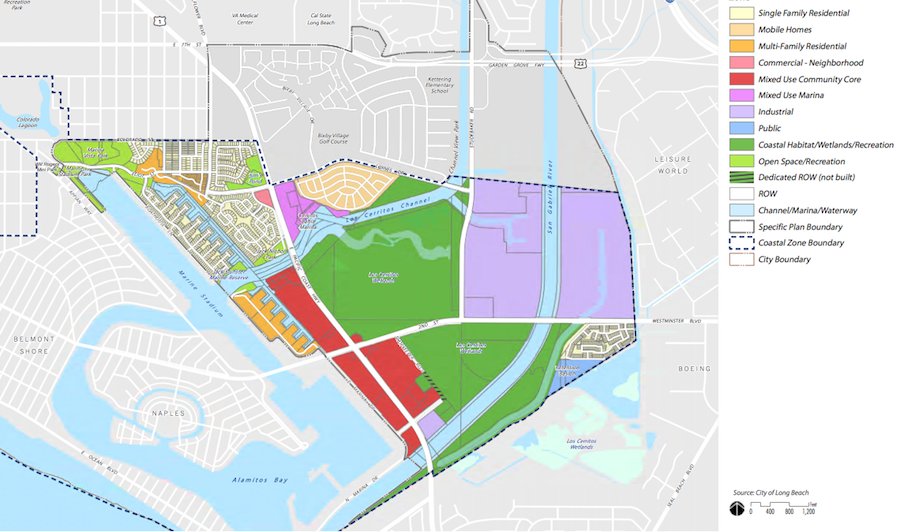
An overview of the SEASP project area from the city’s environmental documents.
The move from SEADIP (Southeast Area Development and Improvement Plan) to SEASP (Southeast Area Specific Plan) was completed last night as the Long Beach City Council approved updates to the oldest land use ordinance in the city, the one governing Southeast Long Beach and the Los Cerritos Wetlands.
SEADIP was approved in 1977 and was due for an overhaul city planners said. Advanced planning officer Christopher Koontz said that in the contemporary sense of the word, SEADIP was not a plan, but SEASP is.
“It wasn’t really a plan,” Koontz said. “It was a collection of rules compiled based on what had been built and what was anticipated to be built but it wasn’t driven by a community vision in the same way that the plan in front of you is.”
The new specific plan provides more guidance to what kind of structures can go where in the region of the city that includes the Marina Pacifica, the wetlands and the soon-to-be-built retail development at 2nd Street and Pacific Coast Highway.
SEASP will allow for greater density, with new buildings in two areas of the region able to build up to five stories high. There is a provision for two parcels of land to build up to seven stories tall, but that would only be if a hotel were included, and those heights could only be reached on 15 percent of the property. The deal would also come with a list of contingencies for the developer to include park space, art, view corridors and/or support for the wetlands.
Third District Councilwoman Suzie Price, who presides over the district where SEASP sits, applauded both city staff and the community for their efforts to craft this update over the course of the last several years. She noted that the original plans called for building heights of up to 12 stories, something she would have never supported, and bristled at the idea that not enough public input was received prior to Tuesday’s vote.
“Yes, it’s true 200 people attending a community meeting certainly does not reflect the population of 500,000 people in the city of Long Beach,” Price said. “But 200 people attending a community meeting, hundreds of people attending 50 community meetings, is very significant in a particular district. I’ve seen outreach unlike that anywhere else in the city.”
The vote was subject to an appeal from Warren Blesofsky, president of the resident advocacy group Long Beach Citizens for Fair Development, a constant challenger to the city’s recent swarm of development deals. Among other things, Blesofsky claimed that environmental protections held under SEADIP would be lost under SEASP, and that a yes vote on the item would lead to the crowding of the area with tall buildings and increased pollution from increased oil production.
Blesofsky pointed to the separate oil consolidation plans currently undertaken by the city in which oil production on two currently unused parcels of the wetlands will be swapped for parcels currently used for production, with the land going back to the city being scheduled for restoration. He claimed that the swap could not be done without the new land use plan, which he said essentially made this an oil drilling vote.
His challenge was declined.
A large number of people from the community turned out to have their voices heard prior to the council’s final vote to implement the new SEASP ordinance. Concerns of density and traffic and even the flight paths of migratory birds—safety glass will be installed to prevent birds crashing into windows—were constant themes from those living in the affected area of the city.
Former City Councilwoman Jan Hall, who served as the chair of the original SEADIP committee, opposed the plan because of the lack of traffic mitigations that she said will be needed even without new developments in the area. The proposed heights, though, would irreparably change that portion of the Third District, Hall said.
“That kind of height will really create a very different situation on Pacific Coast Highway than is being envisioned by the planning department and the consultants,” Hall said. “By that, I mean if you have five and seven story buildings along Pacific Coast Highway, effectively from Loynes Drive to the Seal Beach border, you really are creating a barrier along that whole stretch of land.”
Elizabeth Lambe, executive director of the Los Cerritos Wetlands Land Trust, said that the group would be pushing for further amendments to the SEASP plan as the yet-to-be finalized general plan process will allow another window for changes to SEASP. It wants further reduced density, 100,000 square feet of commercial development above the existing amount, 1,000 new dwelling units and redevelopment of the existing hotel rooms.
“We’re not saying don’t do anything, we’re saying do something that’s reasonable and balanced and protects an important resource,” Lambe said, asking the council to pass something that balances development with conservation.


